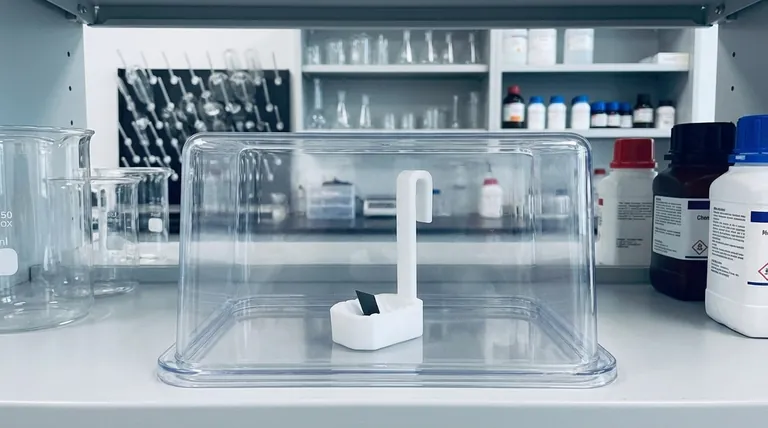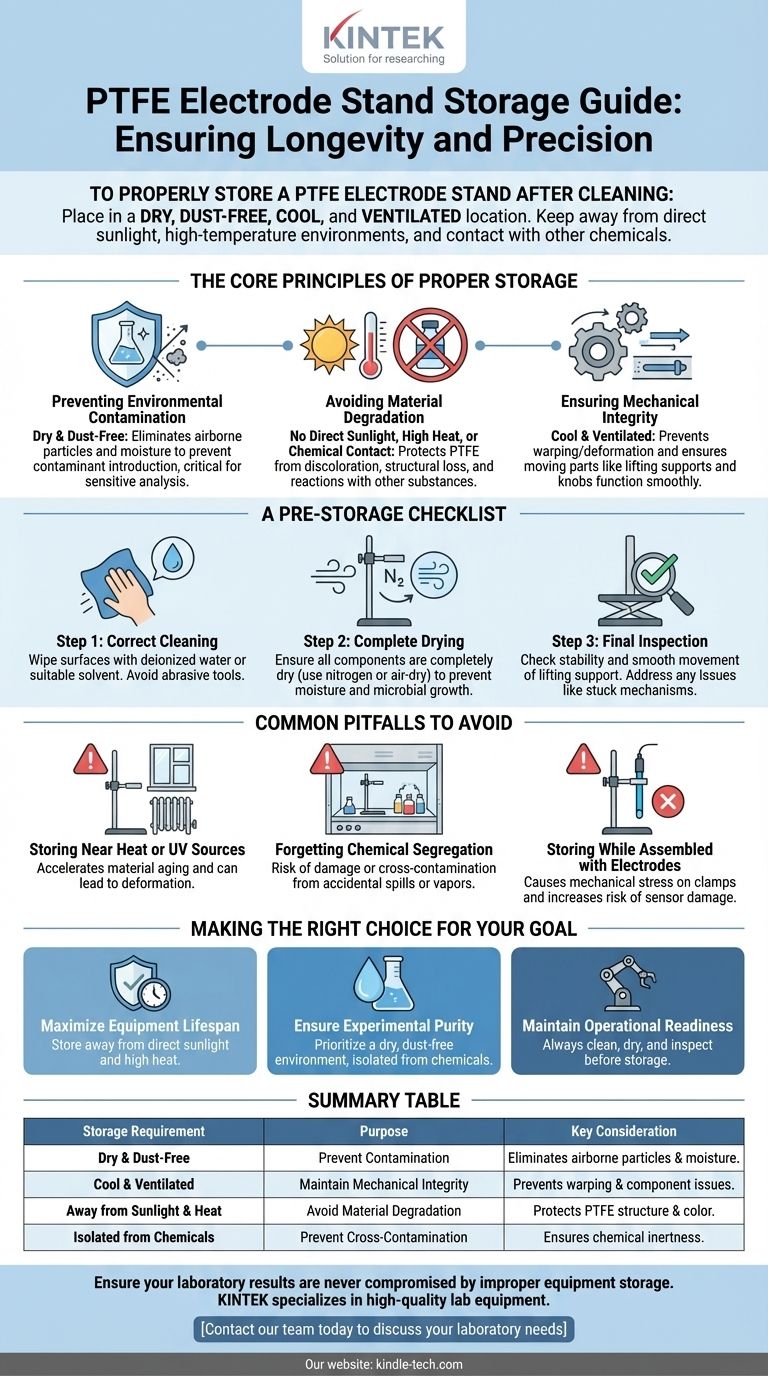To properly store a PTFE electrode stand after cleaning, place it in a dry, dust-free, cool, and ventilated location. It must be kept away from direct sunlight, high-temperature environments, and contact with other chemicals to prevent contamination and material degradation.
The goal of proper storage extends beyond simple organization. It is a critical procedural step to preserve the chemical inertness and mechanical integrity of the stand, thereby safeguarding the accuracy of your future experiments.

The Core Principles of Proper Storage
Understanding the "why" behind storage guidelines ensures your equipment remains in optimal condition. The primary objectives are to prevent contamination, avoid material degradation, and maintain the stand's mechanical function.
Preventing Environmental Contamination
A dry and dust-free location is non-negotiable. Airborne dust and residual moisture can settle on the stand's surfaces, introducing contaminants that could compromise the integrity of subsequent experiments.
This is especially critical in sensitive electrochemical analysis where even trace impurities can alter results.
Avoiding Material Degradation
PTFE is highly resilient, but prolonged exposure to certain conditions can still cause damage. Direct sunlight and high temperatures can lead to discoloration or a loss of structural integrity over time.
Furthermore, while PTFE is chemically inert, storing the stand in contact with other chemicals risks a reaction with non-PTFE components or can lead to cross-contamination.
Ensuring Mechanical Integrity
The stand's functionality depends on its mechanical parts, such as the lifting support and adjustment knobs. A cool, ventilated environment helps prevent any potential warping or deformation of the base.
Proper storage also protects these mechanisms from accumulating dust or grime that could cause them to seize or operate poorly.
A Pre-Storage Checklist
Before you store the stand, a few preparatory steps are essential to ensure it is ready for its next use.
Step 1: Correct Cleaning
The process begins with proper cleaning. Always wipe the surfaces with deionized water or a suitable solvent. Never use abrasive tools like steel wool, which can create scratches that trap contaminants.
Step 2: Complete Drying
After cleaning, all components must be dried completely. You can use a stream of nitrogen gas for rapid drying or simply allow the components to air-dry naturally. Storing a damp stand can trap moisture and promote microbial growth.
Step 3: Final Inspection
Before storing, perform a quick inspection. Ensure the base is stable and the lifting support slides smoothly. Addressing any issues, such as a stuck mechanism that may need cleaning or light lubrication, before storage ensures the stand is always ready for immediate use.
Common Pitfalls to Avoid
Simple oversights in storage can inadvertently damage equipment or compromise data quality.
Storing Near Heat or UV Sources
Placing the stand near a window, heating vent, or other lab equipment that generates heat is a common mistake. This accelerates material aging and can lead to deformation.
Forgetting Chemical Segregation
Do not store the electrode stand in a general chemical storage area. Accidental spills or vapors from other containers can damage the stand or contaminate its surfaces.
Storing While Assembled with Electrodes
Always remove electrodes and other components before long-term storage. This prevents mechanical stress on the clamps and reduces the risk of accidental damage to delicate sensors.
Making the Right Choice for Your Goal
Your storage protocol should align directly with your primary laboratory objectives.
- If your primary focus is maximizing equipment lifespan: Store the stand away from direct sunlight and high heat to prevent material degradation and physical warping.
- If your primary focus is ensuring experimental purity: Prioritize a dry, dust-free environment, completely isolated from other chemicals to eliminate any risk of cross-contamination.
- If your primary focus is maintaining operational readiness: Always perform a clean, dry, and inspect cycle before storage to ensure the stand's mechanical parts function perfectly on demand.
Properly maintaining your equipment is a direct investment in the reliability of your work.
Summary Table:
| Storage Requirement | Purpose | Key Consideration |
|---|---|---|
| Dry & Dust-Free | Prevent Contamination | Eliminates airborne particles and moisture that can compromise experiments. |
| Cool & Ventilated | Maintain Mechanical Integrity | Prevents warping or deformation of the base and moving parts. |
| Away from Sunlight & Heat | Avoid Material Degradation | Protects PTFE from discoloration and loss of structural integrity. |
| Isolated from Chemicals | Prevent Cross-Contamination | Ensures chemical inertness is preserved, even from vapors or spills. |
Ensure your laboratory results are never compromised by improper equipment storage. KINTEK specializes in high-quality lab equipment and consumables, including PTFE electrode stands designed for durability and precision. Our experts can help you select the right equipment and establish best-practice maintenance protocols to protect your investment and ensure data integrity. Contact our team today to discuss your laboratory needs and discover how we can support your research goals.
Visual Guide

Related Products
- Custom PTFE Wafer Holders for Lab and Semiconductor Processing
- Custom PTFE Teflon Parts Manufacturer for PTFE Measuring Cylinder 10/50/100ml
- Custom PTFE Teflon Parts Manufacturer for PTFE Mesh F4 Sieve
- Custom PTFE Teflon Parts Manufacturer for Culture Dish and Evaporation Dish
- Custom PTFE Teflon Parts Manufacturer for Hollow Etching Flower Basket ITO FTO Developing Glue Removal
People Also Ask
- What materials are the sample holders made of? Engineered with PTFE and PEEK for Purity
- How should a PTFE cleaning basket be stored when not in use? Maximize Lifespan & Prevent Contamination
- How can corrosion of the sample holder be prevented when using corrosive chemicals? Protect Your Lab's Integrity
- What is the correct way to place items into a PTFE cleaning basket? Master the Art of Perfect, Repeatable Cleaning
- What are the recommended and prohibited cleaning methods for the PTFE electrode stand? Protect Your Lab Equipment



















